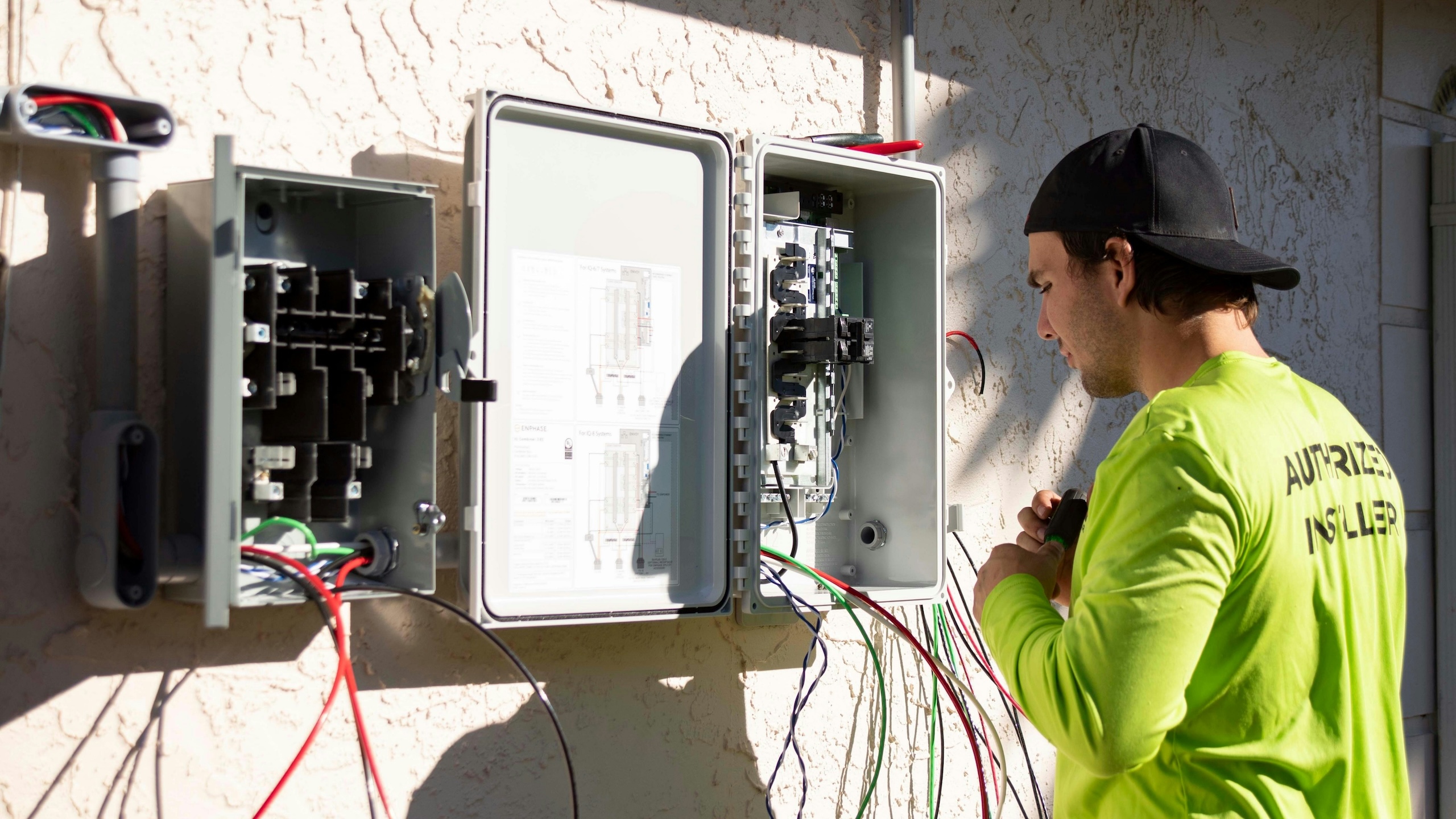
Introduction
For many small electrical contracting businesses, hitting around $20,000 in monthly revenue feels like a milestone. It’s a number that suggests steady work, reliable demand, and a solid reputation. In fact, this number can be achieved without electrician scheduling software. But, for countless electricians, this figure also becomes a frustrating ceiling. No matter how many hours they work or how many jobs they book, breaking through to the next tier of revenue feels elusive.
Why does this plateau occur? The challenge isn’t usually a lack of skill or customer demand: electricians are in higher demand than ever. Instead, the bottleneck often comes from inefficiencies in scheduling, quoting, invoicing, and communication. These administrative burdens eat into valuable billable hours, preventing small shops from scaling further.
The good news is that electricians don’t need to double their crew size or take on unsustainable overtime to surpass this barrier. By streamlining workflows and focusing on growth levers, electrical contractors can unlock new revenue tiers. In this article, we’ll explore why the $20K/month ceiling exists, what strategies electricians can use to break through it, and how Jetmir FSM provides the right tools to make the leap possible.
What is the Electrician Industry Landscape Like?
Electricians are vital to both residential and commercial infrastructure. According to the U.S. Bureau of Labor Statistics (BLS), employment of electricians is projected to grow by 6% from 2022 to 2032, faster than the average for all occupations. Median annual wages hover around $61,500, with top earners exceeding $100,000 .
Industry-wide, the U.S. electrical contracting sector is massive. IBISWorld reports that the market generates over $250 billion annually, with demand driven by new construction, retrofitting older buildings, and the accelerating push for electrification (from EV charging stations to solar and smart home installations) .
Yet, despite the industry’s size, most electrical firms are small. According to Electrical Contractor Magazine, more than 70% of electrical contracting businesses employ fewer than 10 electricians . These smaller firms often rely on manual processes, which makes scaling difficult.
The implication is clear: while demand is strong, capturing it requires more than just technical skill. To break the $20K/month ceiling, small electrical businesses need to improve their operational efficiency.
Why Electricians Hit the $20K/Month Ceiling?
For many independent electricians or small teams, $20,000/month represents the maximum capacity of what a crew of 2–4 electricians can generate without significant workflow improvements. Here’s why:
- Scheduling bottlenecks
Without advanced scheduling tools, dispatching often leads to wasted time between jobs, miscommunications, and underutilized hours. - Slow quoting and estimates
Paper-based or manual estimates delay job approvals. Customers who wait too long for quotes may hire another electrician. - Compliance and safety requirements
Electricians spend significant time managing permits, safety inspections, and NEC compliance paperwork — often without streamlined documentation tools. - Lack of systematic upselling
Many small shops miss opportunities to upsell panel upgrades, surge protection, EV chargers, or preventative maintenance plans. - Administrative overhead
Invoices, follow-ups, and payment tracking consume hours each week that could otherwise be billed.
The result? Even when electricians are busy, they’re capped by inefficiencies that keep revenue around the $20K/month mark.
What are Some Pathways to Breaking the Revenue Ceiling?
The key to scaling past $20,000/month isn’t working harder; it’s working smarter. Electricians can adopt several strategies to push beyond the plateau:
- Specialize in higher-margin services
Jobs like commercial wiring, EV charging station installation, smart home system setup, and emergency electrical repairs command higher rates than routine service calls. - Introduce service contracts
Offering maintenance contracts to property managers, small businesses, and multi-family units creates recurring revenue and predictable cash flow. - Optimize utilization rates
By reducing downtime between jobs and minimizing no-shows, electricians can complete more billable work within the same hours. - Improve quote-to-job conversion
Faster, professional estimates which are delivered digitally with built-in approval links, increase close rates. - Leverage reputation and marketing
A steady stream of online reviews, local SEO optimization, and referral incentives can generate higher-quality leads at lower cost.
By aligning their services with these growth levers, electricians can begin to move past the revenue ceiling. But strategy alone isn’t enough; execution requires the right tools.
How does Jetmir Electrician Scheduling Software Help Electricians Scale?
This is where Jetmir FSM (field service management) makes the difference. Designed specifically for trades like electricians, Jetmir eliminates the bottlenecks that hold back small-to-mid-sized contracting businesses.
End-to-End Workflow Automation
With Jetmir, every step of the job lifecycle is connected:
- Estimates are created quickly and shared digitally.
- Customers approve estimates online.
- Jobs are scheduled with one click.
- Completed jobs convert seamlessly into invoices.
- Payments are tracked in real time.
This eliminates redundant data entry and ensures nothing falls through the cracks.
Real-time customer communication
Electricians can communicate with customers directly inside the digital estimate or invoice portal. Instead of messy text threads, clients ask questions and receive answers within a professional interface. On the electrician’s side, every interaction is logged for accountability.
Compliance-ready documentation
Jetmir lets contractors upload inspection reports, permits, and safety forms directly into the job record. This is critical in an industry where NFPA 70 (National Electrical Code) compliance is non-negotiable.
Transparent, seat-based pricing
Unlike competitors such as ServiceTitan or Jobber, Jetmir does not lock features behind expensive tiers. Every feature, from scheduling to reporting, is included at a flat $34.99/seat/month. That means a three-person crew pays about $105/month, compared to $400–$600/month with tiered competitors.
Accounting & payments integration
Transactional history is easily exported into reports and payments are tracked in detail, including partial payments across different methods of payment. Offering the ability to accept payments is currently in the works, and will be available in the 4th quarter of 2025.
Analytics for smarter growth
The built-in analytics dashboard reveals which job types are most profitable, which customers generate repeat work, and whether revenue trends are on track to exceed $20K/month.
In short, Jetmir provides electricians with the infrastructure they need to scale sustainably.
What are Pricing Benchmarks for Electricians?
Pricing is one of the biggest concerns when choosing FSM software. Many electricians hesitate to adopt new platforms because of unpredictable costs. Here’s how Jetmir compares:
- ServiceTitan: Industry leader, but costs often exceed $100–$200/user/month, with add-ons for features like advanced reporting .
- Jobber: Popular with small contractors, but tiers range from $69 to $259/month, with limits on users and features .
- Housecall Pro: Simpler option, $65–$169/month depending on tier and team size .
- Jetmir: $34.99/seat/month, all features included, no hidden tiers .
For electricians managing crews of 3–10, Jetmir’s flat pricing can result in thousands of dollars in annual savings, freeing up capital to reinvest in marketing or hiring.
What is the ROI of Scaling Electrician Contractor Growth with an FSM?
Let’s put the numbers into perspective.
Imagine a small shop with three electricians:
- Average hourly rate: $80/hour.
- Average billable hours per electrician: 20 hours/week.
- Weekly revenue: 3 × 20 × $80 = $4,800.
- Monthly revenue: ~$19,200.
This is where many contractors plateau. Now add Jetmir:
- 15% reduction in idle time through smarter scheduling = +9 hours/week.
- 10% higher quote conversion from faster digital estimates.
- Fewer lost invoices thanks to automated follow-ups.
With these improvements, the same crew could generate:
- ~75 additional billable hours per month.
- ~$6,000 more revenue per month.
That puts the business in the $25K–$30K/month range — without hiring more staff or increasing hours.
Electrical Contractor Magazine notes that firms adopting digital workflows consistently report improved job efficiency and customer satisfaction . For electricians, the math is clear: FSM software isn’t an expense: it’s a profit driver.
Conclusion
Breaking the $20K/month ceiling is a challenge faced by countless electricians. It’s not a reflection of skill or demand, but of the operational bottlenecks that cap growth. By introducing higher-margin services, creating recurring revenue streams, and, most importantly, streamlining workflows – electrical contractors can scale past this plateau.
Jetmir FSM was built for exactly this purpose. With transparent pricing, end-to-end job management, and real-time client communication, Jetmir empowers electricians to grow smarter, not harder.
If you’re ready to break through the $20K/month barrier and unlock the next phase of your electrical business, now is the time to act.
References
- U.S. Bureau of Labor Statistics. “Electricians: Occupational Outlook Handbook.” https://www.bls.gov/ooh/construction-and-extraction/electricians.htm
- IBISWorld. “Electrical Contractors in the US – Market Size 2005–2029.” https://www.ibisworld.com/united-states/market-research-reports/electrical-contractors-industry/
- Electrical Contractor Magazine. “2024 Profile of the Electrical Contractor.” https://ecmag.com/
- National Fire Protection Association. “NFPA 70: National Electrical Code.” https://www.nfpa.org/
- Capterra. “ServiceTitan Pricing.” https://www.capterra.com/p/141101/ServiceTitan/
- Jetmir.io. “Pricing.” https://jetmir.io/#price





